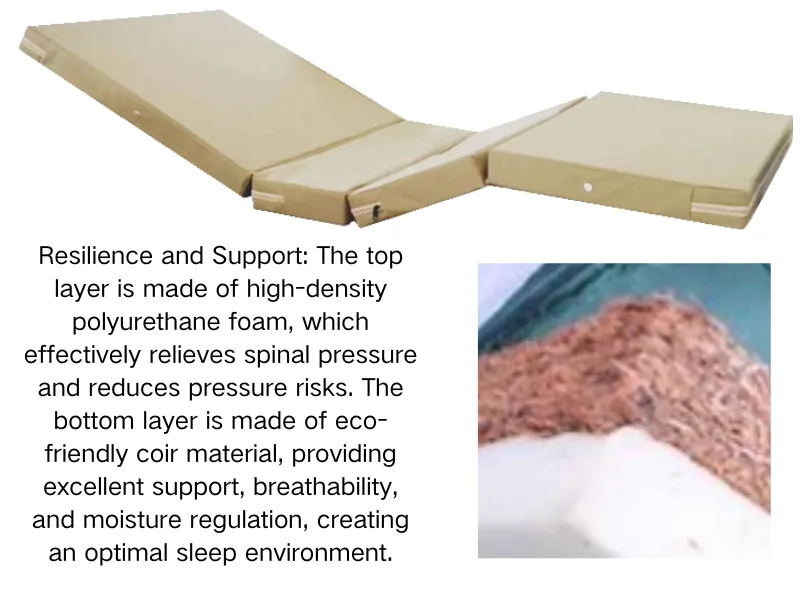hospital bed mattress for pressure ulcers
Understanding Hospital Bed Mattresses for Pressure Ulcers A Comprehensive Guide
Pressure ulcers, also known as bedsores or pressure sores, are a significant health concern, especially for individuals with limited mobility. These injuries occur when there is prolonged pressure on the skin, often over bony areas such as the hips, heels, and tailbone. The implications of pressure ulcers can be severe, leading to infection, prolonged hospitalizations, and increased healthcare costs. One of the critical components in preventing these ulcers is the type of mattress used in hospital beds.
The Importance of Hospital Bed Mattresses
Hospital bed mattresses play a crucial role in patient care, particularly for those who are bedridden or have limited ability to change positions. A suitable mattress can help redistribute pressure across the body, ensuring that no single area bears too much load for too long. The choice of mattress can significantly affect the patient's comfort, skin integrity, and overall healing process.
Types of Hospital Bed Mattresses
1. Innerspring Mattresses These traditional mattresses use coils to provide support. While they offer some comfort, they tend not to conform to the body’s shape as well as other types of mattresses, which can lead to pressure points and increase the risk of ulcers.
2. Foam Mattresses High-density foam mattresses are designed to offer greater pressure relief by conforming to the body’s contours. They are lightweight, easy to handle, and can provide adequate support for many patients. However, they may not be sufficient for more high-risk patients who require specialized care.
3. Alternating Pressure Mattresses These dynamic mattresses consist of a series of air bladders that inflate and deflate in a cycle, redistributing pressure and reducing the risk of pressure ulcers. They are particularly beneficial for patients who are at high risk due to limited mobility or existing wounds.
4. Low Air Loss Mattresses These advanced mattresses use a constant airflow to keep the skin dry and reduce moisture buildup, which is crucial in preventing skin breakdown. They are often used in tandem with alternating pressure features, providing both support and moisture management.
5. Gel-Infused Mattresses Incorporating gel materials helps distribute pressure evenly and can regulate temperature, keeping the patient comfortable. These mattresses can be particularly beneficial for patients prone to overheating.
hospital bed mattress for pressure ulcers

Considerations for Choosing the Right Mattress
When selecting a hospital bed mattress for preventing and managing pressure ulcers, several factors must be taken into account
- Patient Risk Level Assess the patient’s risk for developing pressure ulcers using tools such as the Braden Scale. High-risk patients may require specialized mattresses, such as low air loss or alternating pressure models.
- Mobility Levels Consider the patient’s ability to reposition themselves. Those with more mobility may benefit from foam mattresses, while immobile patients may need advanced pressure-relieving systems.
- Skin Integrity Evaluate the patient’s skin condition. Those with existing pressure ulcers or compromised skin may require more sophisticated support systems.
- Weight Distribution Heavier patients may need mattresses specifically designed to accommodate greater weight without sacrificing support or pressure relief.
- Care Requirements Consider how easy the mattress is to clean and maintain, as infection control is paramount when dealing with vulnerable patients.
Conclusion
The choice of a hospital bed mattress is essential in preventing pressure ulcers and promoting overall patient care. Proper assessment of the patient’s needs, combined with knowledge of the various types of mattresses available, can help healthcare professionals make informed decisions. By investing in the right mattress, the likelihood of pressure ulcer development can be significantly reduced, leading to better patient outcomes and improved quality of life. It is vital for healthcare providers to stay updated with the latest in mattress technology and care strategies to ensure optimum protection for their patients.
-
Mattresses Designed for Back Pain ReliefNewsAug.08,2025
-
Innovative Wave Mattresses for Ultimate ComfortNewsAug.08,2025
-
High-Quality Mattresses for Hospital BedsNewsAug.08,2025
-
High-Quality Mattresses for Every NeedNewsAug.08,2025
-
Healthcare Foam Mattress: Sleep Better, Heal FasterNewsAug.08,2025
-
Cube Mattress for Daily ComfortNewsAug.08,2025
-
How Hospital Mattress Choices Directly Impact Patient Comfort and CareNewsAug.05,2025

